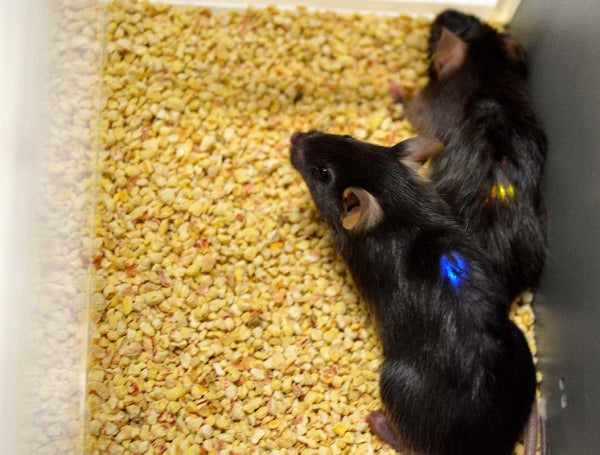A technique called optogenetics has transformed neuroscience during the past 10 years by allowing researchers to turn specific neurons on and off in experimental animals. By flipping these neural switches, it has provided clues about which brain pathways are involved in diseases like depression and obsessive-compulsive disorder. “Optogenetics is not just a flash in the pan,” says neuroscientist Robert Gereau of Washington University in Saint Louis. “It allows us to do experiments that were not doable before. This is a true game changer like few other techniques in science.”
Since the first papers were published on optogenetics in the mid-aughts some researchers have mused about one day using optogenetics in patients, imagining the possibility of an off-switch for depression, for instance.
The technique, however, would require that a patient submit to a set of highly invasive medical procedures: genetic engineering of neurons to insert molecular switches to activate or switch off cells, along with threading of an optical fiber into the brain to flip those switches. Spurred on by a set of technical advances, optogenetics pioneer Karl Deisseroth, together with other Stanford University researchers, has formed a company to pursue optogenetics trials in patients within the next several years—one of several start-ups that are now contemplating clinical trials of the technique.
On supporting science journalism
If you're enjoying this article, consider supporting our award-winning journalism by subscribing. By purchasing a subscription you are helping to ensure the future of impactful stories about the discoveries and ideas shaping our world today.
Circuit Therapeutics, founded in 2010, is moving forward with specific plans to treat neurological diseases. (It also partners with pharmaceutical companies to help them use optogenetics in animal research to develop novel drug targets for human diseases.) Circuit wants to begin clinical trials for optogenetics to treat chronic pain, a therapy that would be less invasive than applications requiring implantation deep inside the brain. Neurons affected by chronic pain are relatively accessible, because they reside in and just outside the spinal cord, an easier target than the brain. Even nerve endings in the skin might be targeted, making them much easier to reach. “In animal models it works incredibly well,” says Scott Delp, a neuroscientist at Stanford, who collaborates with Deisseroth. The firm is also working to develop treatments for Parkinson’s and other neurological disorders.
Interest in optogenetics and closely related therapies in patients is growing. RetroSense Therapeutics, a Michigan-based company, has reported plans to soon begin human trials of optogenetics for a genetic condition that causes blindness. The new technology relies on opsins, a type of ion channel consisting of proteins that conduct neurons’ electrical signaling. Neurons contain hundreds of different types of ion channels but opsins open in response to light. Some opsins are found in the human retina but those used in optogenetics are derived from algae and other organisms. The first opsins used in optogenetics, called channel rhodopsins, open to allow positively charged ions to enter the cell when activated by a flash of blue light, which causes the neuron to fire an electrical impulse. Other opsin proteins pass inhibitory, negatively charged ions in response to light, making it possible to silence neurons as well. Researchers have widely expanded the arsenal of available opsins with genetic engineering, for example making ones that stay open in response to a short burst of light
The main challenge before optogenetic therapies become a reality is getting opsin genes into the adult human neurons to be targeted in a treatment. In rodents researchers have employed two main strategies: transgenics, in which mice are bred to make opsins in specific neurons—an option unsuitable for use in humans. The other method uses a virus to implant a gene into a neuron. Viruses are currently being used for other types of gene therapy in humans, but challenges remain. Viruses must penetrate mature neurons and deliver their gene cargo without spurring an immune reaction. Then the neuron has to express the opsin in the right place, and it has to go on making the protein continuously—ideally forever.
Delp and others have achieved pain relief in rodents following viral delivery by activating the opsin to shut down a pain-producing circuit. “Two weeks after a single injection of virus containing a gene for an inhibitory opsin into the peripheral nerve, we see robust expression of opsin in neurons all the way down to the skin. All we have to do is illuminate the skin and we can suppress painful touch and heat sensitivity—a major symptomatic problem in humans with chronic pain,” Delp says. Whether the technique will actually work in people remains to be seen.
The second hurdle is to deliver light to the opsin-containing neurons to turn on or off the desired brain circuit. In humans light delivery to the brain would require major surgery but silencing the neurons that convey pain would be far less invasive—perhaps even as simple as applying a light-emitting patch. Recently Gereau, in collaboration with John Rogers at the University of Illinois at Urbana–Champaign, developed devices implanted in rodents atop peripheral nerves or the spinal cord that are miniaturized, fully implantable and wirelessly powered by radio frequency energy. Electrical engineer Ada Poon at Stanford, in collaboration with Delp and Deisseroth, recently developed a similar wireless implantable device for use in rodents.
Although neurons outside the brain are more accessible, they are also difficult to activate with light, because—much like people—experimental animals are rarely still, and a rigid light-emitting device could damage delicate nerve tissue. But Gereau’s new devices are flexible and stretchable, so they move with the animals. The researcher is convinced that optogenetics for human therapies are now in the early stages of development. “I certainly believe there is therapeutic potential for optogenetics,” he says. Within a decade, turning off pain neurons may differ little from flipping a light switch.
